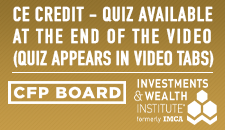To start logging and tracking your CE, sign up for a free Asset TV account today!
MASTERCLASS: Exchange-Traded Funds
|
Three experts unpack some of the key trends and product developments in the ever-growing marketplace. They cover how to think about liquidity and different ETFs in the context of portfolio construction, discuss the findings of a new advisor survey, and much more.
- Bobby Barnes, Head of Quantitative Index Solutions - Fidelity Investments
- David Stack, Senior Capital Markets Specialist Systematic Investment Solutions - DWS - Xtrackers
- Marc Zeitoun, CFA, Head of Strategic Beta - Columbia Threadneedle Investments















